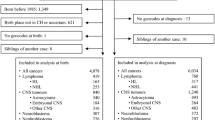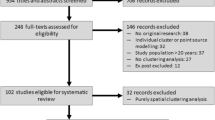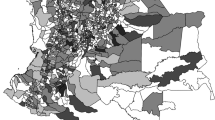Abstract
Aims
The aims of this study are the following: first, to analyze incidence, trends, and survival of nervous system tumors in children under the age of 15 in the Region of Murcia, Spain, during the years 1998–2009 and second, to evaluate if certain environmental exposures may be involved in the etiology of childhood nervous system tumors. The study was performed on the spatial and temporo-spatial distribution of the observed cases.
Methods
The Environment and Pediatric Cancer in the Region of Murcia is an ongoing research project aimed at carefully collecting pediatric environmental history (PEH) and to use geographical information systems to map the incidence and to analyze the geographical distribution of pediatric cancer incidence in our region. Between 1998 and 2009, 125 patients were diagnosed with nervous system tumors. The spatial and temporal space clusters were evaluated using Kulldorff's statistics. Address at diagnosis was the main feature evaluated.
Results
The incidence (cases/million children) for central nervous system (CNS) tumors was 34.2, that for sympathetic nervous system tumors was 10.9, and that for retinoblastoma was 1.9. There was evidence of space clustering for medulloblastoma and space–time clustering for all tumors, CNS tumors, astrocytoma, and neuroblastoma.
Conclusions
The incidence and survival for each type and subtype of nervous system tumors were within the reported values for the European region. There is evidence that spatial and spatial–temporal distribution in these cases is not random. The development of a careful PEH in these patients will help to reinforce geographical information system studies and to ascertain the importance of associated risk factors.


Similar content being viewed by others
References
Kaatsch P (2010) Epidemiology of childhood cáncer. Cancer Treat Rev 36:277–285
Makino K, Nakamura H, Yano S, Kuratsu J, Kumamoto Brain Tumor Group (2010) Population-based epidemiological study of primary intracranial tumors in childhood. Childs Nerv Syst 26:1029–1034
Altekruse SF, Kosary CL, Krapcho M et al. (eds) (2010) SEER cancer statistics review, 1975–2007, National Cancer Institute. Bethesda, MD, http://seer.cancer.gov/csr/1975_2007/, based on November 2009 SEER data submission, posted to the SEER website
Parkin DM, Kramarova E, Draper GJ (1998) International incidence of childhood cancer. IARC Scientific Publications no. 1, Lyon
Stiller CA, Marcos-Gragera R, Ardanaz E, Pannelli F, Almar Marqués E, Cañada Martinez A, Steliarova-Foucher E (2006) Geographical patterns of childhood cancer incidence in Europe, 1988–1997. Report from the automated childhood cancer information system project. Eur J Cancer 42:1952–1960
Spix C, Pastore G, Sankila R, Stiller CA, Steliarova-Foucher E (2006) Neuroblastoma incidence and survival in European children (1978–1997): report from the Automated Childhood Cancer Information System project. Eur J Cancer 42:2081–2091
Broaddus E, Topham A, Singh AD (2009) Incidence of retinoblastoma in the USA: 1975–2004. Br J Ophthalmol 93:21–23
Ortega-García JA, López-Hernández FA, Sobrino-Najul E et al (2011) Environment and paediatric cancer in the Region of Murcia (Spain): integrating clinical and environmental history in a geographic information system. An Pediatr (Barc) 74:255–260. doi:10.1016/j.anpedi.2010.11.005
Ferrís Tortajada J, Ortega García JA, Marco Macián A, García Castell J (2004) Environment and pediatric cancer. An Pediatr (Barc) 61:42–50
McNally RJ, Alston RD, Eden TO, Kelsey AM, Birch JM (2004) Further clues concerning the aetiology of childhood central nervous system tumours. Eur J Cancer 40:2766–2772
McNally RJ, Eden TO, Alexander FE, Kelsey AM, Birch JM (2005) Is there a common aetiology for certain childhood malignancies? Results of cross-space-time clustering analyses. Eur J Cancer 41:2911–2916
Houben MP, Coebergh JW, Birch JM, Tijssen CC, van Duijn CM, McNally RJ (2005) Space-time clustering patterns of gliomas in The Netherlands suggest an infectious aetiology. Eur J Cancer 41:2917–2923
Padrón Municipal de Habitantes. Instituto Nacional Estadística [consultado 30/6/2010]. Accessed at: http://www.ine.es
Centro Regional de Estadística de Murcia. ECONET. Consejería de Economía y Hacienda [consultado 30/6/2010]. Accessed at: http://www.carm.es/econet. Región de Murcia, Spain
Percy C, Fritz A, Jack A, Shanmugarathan S, Sobin L, Parkin DM, Whelan S (2000) International Classification of Diseases for Oncology (ICD-O), 3rd edn. World Health Organization, Geneva
Steliarova-Foucher E, Stiller C, Lacour B, Kaatsch P (2005) International classification of childhood cancer, third edition. Cancer 103:1457–1467
International Agency for Research on Cancer (IARC) (2011) Overall evaluations of carcinogenicity to humans. IARC Monographs volumes 1–82. http://monographs.iarc.fr/ENG/Classification/index.php. Accessed 15 April 2011
National Toxicology Program (2002) Report on carcinogens, 11th edition. US Department of Health and Human Services, Public Health Service. http://ehp.niehs.nih.gov/roc/toc10.html. Accessed 25 Dec 2010
Kulldorff M, Feuer EJ, Miller BA, Freedman LS (1997) Breast cancer clusters in the northeast United States: a geographic analysis. Am J Epidemiol 146:161–170
Pfeiffer D, Stevenson M, Stevens KB, Robinson TP, Rogers DJ, Clements ACA (2008) Spatial analysis in epidemiology. Oxford University Press, Oxford
Kulldorff M, Athas W, Feuer E, Miller B, Key C (1998) Evaluating cluster alarms: a space-time scan statistic and brain cancer in Los Alamos. Am J Public Health 88:1377–1380
Kulldorff M, Heffernan R, Hartman J, AssunçãoMR MF (2005) A space-time permutation scan statistic for the early detection of disease outbreaks. PLoS Med 2:216–224
Dwass M (1957) Modified randomization tests for nonparametric hypotheses. Ann Math Stat 28:181–187
Schmidt LS, Schmiegelow K, Lahteenmaki P, Träger C, Stokland T, Grell K, Gustafson G, Sehested A, Raashou-Nielsen O, Johansen C, Schüz J (2011) Incidence of childhood central nervous system tumors in the Nordic countries. Pediatr Blood Cancer 56:65–69
Ortega-García JA, Martin M, López-Fernández MT, Fuster-Soler JL, Donat-Colomer J, López-Ibor B, Claudio L, Ferrís-Tortajada J (2010) Transgenerational tobacco smoke exposure and childhood cancer: an observational study. J Paediatr Child Health 46:291–295
Bunin GR, Orjuela M (2007) Geographic and environmental factors. In: Singh AD, Damato BE, Pe'er J et al (eds) Clinical ophthalmic oncology. Saunders-Elsevier, Philadelphia, pp 410–416
Peris-Bonet R, Salmerón D, Martínez-Beneito MA, Galceran J, Marcos-Gragera R, Felipe S, González V, de Toledo S, Codina J, Spanish Childhood Cancer Epidemiology Working Group (2010) Childhood cancer incidence and survival in Spain. Ann Oncol 21(Suppl 3):103–110
Gatta G, Zigon G, Capocaccia R, Coebergh JW, Desandes E, Kaatsch P, Pastore G, Peris-Bonet R, Stiller CA, EUROCARE Working Group (2009) Survival of European children and young adults with cancer diagnosed 1995–2002. Eur J Cancer 45:992–1005
Amin R, Bohnert A, Holmes L, Rajasekaran A, Assanasen C (2010) Epidemiologic mapping of Florida childhood cancer clusters. Pediatr Blood Cancer 54:511–518
McNally RJ, Alexander FE, Bithell JF (2006) Space-time clustering of childhood cancer in great Britain: a national study, 1969–1993. Int J Cancer 118:2840–2846
McNally RJ, Cairns DP, Eden OB, Alexander FE, Taylor GM, Kelsey AM, Birch JM (2002) An infectious aetiology for childhood brain tumours? Evidence from space-time clustering and seasonality analyses. Br J Cancer 86:1070–1077
Rice JM (2004) Causation of nervous system tumors in children: insights from traditional and genetically engineered animal models. Toxicol Appl Pharmacol 199:175–191
Ries LAG, Smith MA, Gurney JG et al. (1999) Cancer incidence and survival among children and adolescents: United States SEER Program 1975–1995, National Cancer Institute, SEER Program NIH Pub No. 99–4649, Bethesda
Zu Rhein GM, Varakis JN (1979) Perinatal induction of medulloblastomas in Syrian golden hamsters by a human polyoma virus (JC). Natl Cancer Inst Monogr 51:205–208
Moll AC, Imhof SM, Cruysberg JR, Schouten-van Meeteren AY, Boers M, van Leeuwen FE (2003) Incidence of retinoblastoma in children born after in-vitro fertilization. Lancet 361:309–310
McNally RJ, Bithell JF, Vincent TJ, Murphy MF (2009) Space-time clustering of childhood cancer around the residence at birth. Int J Cancer 124:449–455
Michael J, Thun MJ, Sinks T (2004) Understanding cancer clusters. CA Cancer J Clin 54:273–280
Acknowledgments
The authors express their gratitude for the support and funding granted by the Fundación para la Formación e Investigación Sanitarias de la Región de Murcia (FFIS) FFIS/EMER09/15 and the Scientific Foundation of the Asociación Española Contra el Cáncer (AECC) (MACAPE-04). Thanks to the project ECO2009-10534/ECON del Ministerio de Ciencia y Tecnología de España and to the project 11897/PHCS/09 de la Fundación Séneca–Agencia de Ciencia y Tecnología de la Región de Murcia. Additionally, we thank Isaedmarie Fevo and Elías Najul from the Mount Sinai International Exchange Program for Minority Students, whose work is supported by grant MD001452 from the National Center on Minority Health and Health Disparities of the National Institutes of Health, and María Martínez from the Technical University of Cartagena.
Conflicts of interest
The authors declare that they have no conflicts of interest.
Author information
Authors and Affiliations
Corresponding author
Rights and permissions
About this article
Cite this article
Ortega-García, J.A., López-Hernández, F.A., Fuster-Soler, J.L. et al. Space–time clustering in childhood nervous system tumors in the Region of Murcia, Spain, 1998–2009. Childs Nerv Syst 27, 1903–1911 (2011). https://doi.org/10.1007/s00381-011-1483-0
Received:
Accepted:
Published:
Issue Date:
DOI: https://doi.org/10.1007/s00381-011-1483-0




